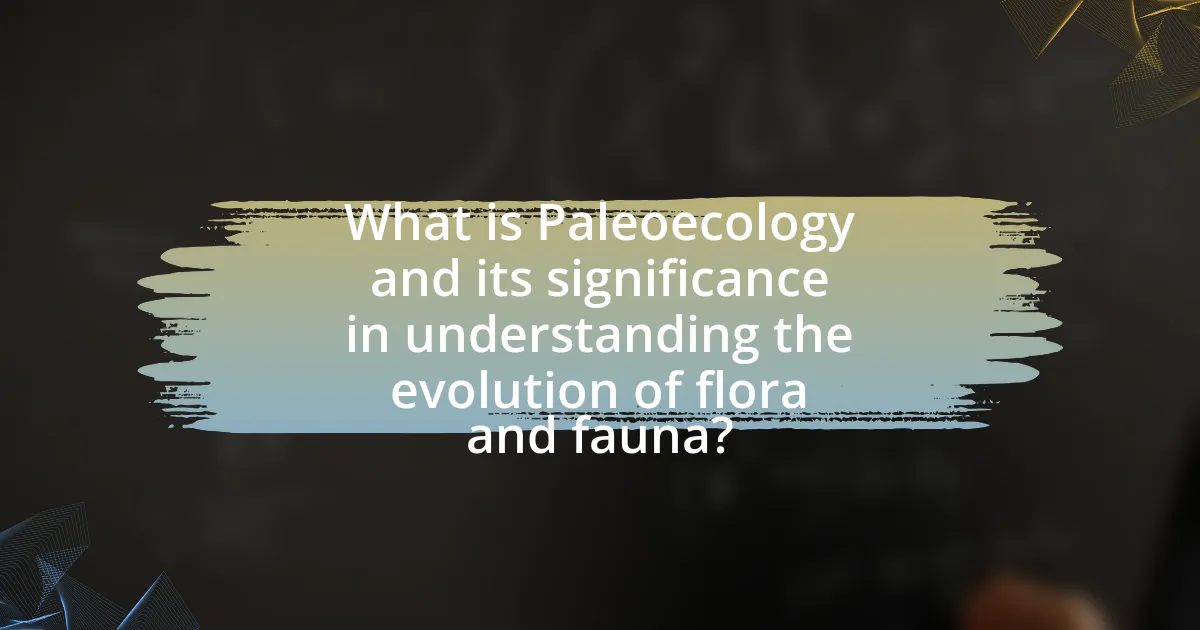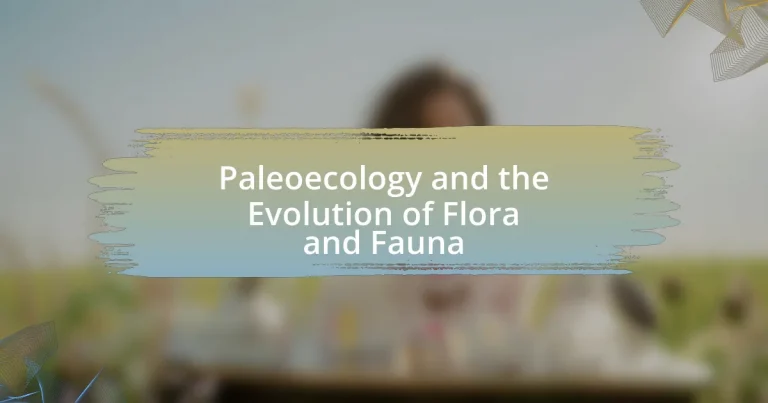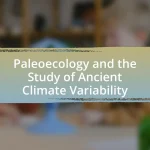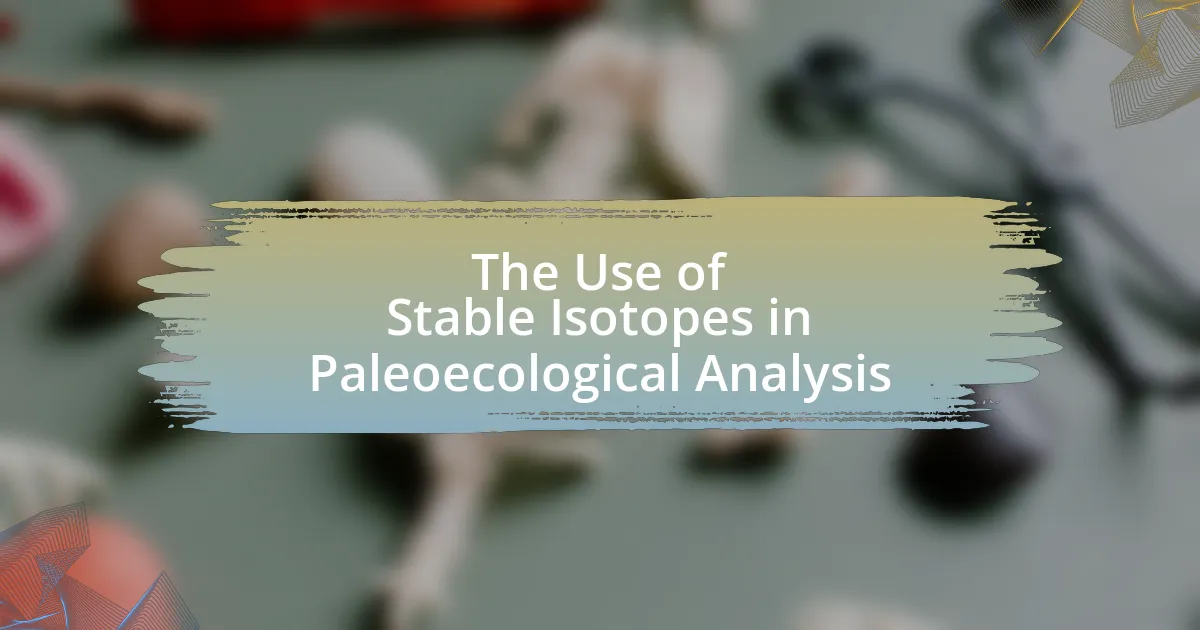Paleoecology is the scientific study of ancient ecosystems and the interactions between organisms and their environments over geological time. This article explores the significance of paleoecology in understanding the evolution of flora and fauna, detailing how fossil records and sediment analysis reveal past climate changes and species interactions. It discusses various research methods, including sediment analysis and isotopic studies, and highlights key periods in the evolution of plant and animal life. Additionally, the article examines how insights from past biodiversity can inform current conservation efforts and sustainable land-use practices, emphasizing the relevance of historical ecological dynamics in addressing contemporary environmental challenges.

What is Paleoecology and its significance in understanding the evolution of flora and fauna?
Paleoecology is the study of ancient ecosystems and the interactions between organisms and their environments over geological time. This field is significant in understanding the evolution of flora and fauna because it provides insights into how past climate changes, geological events, and biotic interactions have shaped the diversity and distribution of species. For example, fossil records and sediment analysis reveal how plant and animal communities responded to past climate shifts, such as the transition from the last Ice Age, which informs current biodiversity patterns and ecological resilience. By examining these historical contexts, paleoecology helps scientists predict how contemporary species might adapt to ongoing environmental changes.
How does paleoecology contribute to our knowledge of past ecosystems?
Paleoecology contributes to our knowledge of past ecosystems by analyzing fossilized remains and sedimentary records to reconstruct ancient environments and their biological communities. This field utilizes data from various sources, such as pollen analysis, isotopic studies, and macrofossil identification, to infer climate conditions, species interactions, and ecological dynamics over geological time scales. For instance, studies of sediment cores from lake beds reveal shifts in vegetation and climate during the last glacial maximum, providing insights into how ecosystems responded to climate change. Such evidence helps scientists understand the resilience and adaptability of flora and fauna, informing current conservation efforts and predicting future ecological responses.
What methods are used in paleoecological research?
Paleoecological research employs several methods, including sediment analysis, fossil examination, and isotopic studies. Sediment analysis involves examining layers of soil and sediment to reconstruct past environments and climate conditions. Fossil examination focuses on identifying and analyzing plant and animal remains to understand biodiversity and ecological interactions over time. Isotopic studies utilize stable isotopes in fossils and sediments to infer past temperatures, precipitation patterns, and food web dynamics. These methods collectively provide insights into historical ecosystems and the evolutionary processes of flora and fauna.
How do fossil records inform our understanding of ancient environments?
Fossil records provide critical insights into ancient environments by revealing the types of organisms that existed, their interactions, and the climatic conditions of their habitats. These records, which include preserved remains, traces, and imprints of organisms, allow scientists to reconstruct past ecosystems and understand the biodiversity and ecological dynamics of different geological periods. For instance, the presence of specific plant fossils can indicate whether an area was once a lush forest or a barren desert, while animal fossils can suggest predator-prey relationships and migration patterns. Additionally, isotopic analysis of fossilized materials can provide data on ancient temperatures and atmospheric conditions, further enhancing our understanding of how environments have changed over time.
Why is the study of flora and fauna evolution important?
The study of flora and fauna evolution is important because it provides insights into the historical interactions between species and their environments, which can inform conservation efforts and biodiversity management. Understanding evolutionary processes helps scientists predict how species may respond to environmental changes, such as climate change, habitat destruction, and invasive species. For instance, research published in “Nature” by authors such as Richard Dawkins highlights how evolutionary adaptations can reveal the resilience of certain species, guiding conservation strategies. This knowledge is crucial for maintaining ecosystem stability and ensuring the survival of diverse species.
What insights can we gain about climate change from studying past species?
Studying past species provides critical insights into climate change by revealing how ecosystems and species responded to historical climate fluctuations. For instance, fossil records indicate that during the Paleocene-Eocene Thermal Maximum, approximately 56 million years ago, global temperatures rose significantly, leading to shifts in species distributions and extinctions. This event demonstrates that rapid climate change can disrupt ecosystems, as seen with the extinction of many marine and terrestrial species. Additionally, examining the adaptations of species during previous climate changes, such as the migration patterns of flora and fauna during glacial and interglacial periods, helps scientists predict how current species might respond to ongoing climate change. These historical patterns underscore the importance of biodiversity in resilience against climate shifts, as diverse ecosystems tend to recover more effectively from environmental stressors.
How does understanding past biodiversity help in conservation efforts today?
Understanding past biodiversity is crucial for informing current conservation efforts by providing insights into species interactions, ecosystem functions, and responses to environmental changes. Paleoecological studies reveal how ecosystems have historically responded to climate shifts, habitat alterations, and species extinctions, which can guide modern conservation strategies. For instance, research indicates that ecosystems with higher historical biodiversity tend to be more resilient to disturbances, as seen in studies of ancient coral reefs that thrived despite past climate fluctuations. This historical context allows conservationists to prioritize the protection of biodiversity hotspots and implement restoration practices that mimic natural processes observed in the past, ultimately enhancing the effectiveness of conservation initiatives.

What are the key periods in the evolution of flora and fauna?
The key periods in the evolution of flora and fauna include the Precambrian, Paleozoic, Mesozoic, and Cenozoic eras. The Precambrian, spanning from Earth’s formation to about 541 million years ago, saw the emergence of simple life forms, including prokaryotes and eukaryotes. The Paleozoic era, lasting from approximately 541 to 252 million years ago, featured significant developments such as the Cambrian explosion, which introduced a wide variety of marine life, and the colonization of land by plants and animals. The Mesozoic era, from about 252 to 66 million years ago, is known as the age of reptiles, including dinosaurs, and marked the rise of flowering plants. Finally, the Cenozoic era, beginning 66 million years ago and continuing to the present, is characterized by the diversification of mammals and birds, as well as the development of modern flora. Each of these periods is crucial for understanding the complex history of life on Earth.
What major events have shaped the evolution of plant life?
Major events that have shaped the evolution of plant life include the colonization of land by plants, the development of vascular tissues, the evolution of seeds, and significant mass extinction events. The transition from aquatic to terrestrial environments around 470 million years ago marked the beginning of land plant evolution, leading to the diversification of plant forms. The emergence of vascular tissues in the Silurian period allowed plants to grow taller and transport water and nutrients more efficiently. The evolution of seeds during the Devonian period provided advantages for reproduction and survival in diverse environments. Additionally, mass extinction events, such as the Permian-Triassic extinction around 252 million years ago, drastically altered ecosystems and allowed for the rise of new plant groups, including flowering plants in the Cretaceous period. These events collectively influenced the diversity and complexity of plant life throughout Earth’s history.
How did the transition from aquatic to terrestrial plants occur?
The transition from aquatic to terrestrial plants occurred through a series of evolutionary adaptations that allowed plants to survive and thrive in land environments. Key adaptations included the development of structures such as roots for anchorage and nutrient absorption, stems for support and transport, and leaves for photosynthesis and gas exchange. Fossil evidence indicates that early land plants, like the ancestors of modern bryophytes, emerged around 470 million years ago, showcasing features that facilitated their survival outside of water. Additionally, the evolution of a cuticle helped reduce water loss, while the development of reproductive strategies, such as spores and seeds, enabled these plants to reproduce in drier conditions. These adaptations collectively illustrate the gradual shift from aquatic habitats to terrestrial ecosystems, marking a significant milestone in the evolution of flora.
What role did the Carboniferous period play in plant evolution?
The Carboniferous period was crucial in plant evolution as it marked the emergence of extensive forests dominated by vascular plants, particularly ferns, horsetails, and seed plants. This period, spanning from approximately 359 to 299 million years ago, saw the development of complex ecosystems that significantly increased atmospheric oxygen levels, which in turn facilitated the evolution of larger plant forms and diverse terrestrial habitats. Fossil evidence indicates that the Carboniferous forests contributed to the formation of vast coal deposits, highlighting the abundance and diversity of plant life during this time.
What significant milestones mark the evolution of animal life?
Significant milestones in the evolution of animal life include the emergence of multicellular organisms, the development of bilateral symmetry, the Cambrian explosion, the colonization of land, and the rise of mammals. The emergence of multicellular organisms around 600 million years ago marked a fundamental shift from unicellular life, allowing for greater complexity. The development of bilateral symmetry, which occurred in early animal lineages, facilitated more efficient movement and predation strategies. The Cambrian explosion, occurring approximately 541 million years ago, resulted in a rapid diversification of life forms and the establishment of most major animal phyla. The colonization of land by arthropods and later vertebrates around 400 million years ago opened new ecological niches. Finally, the rise of mammals during the Mesozoic era, particularly after the extinction of dinosaurs 66 million years ago, led to the dominance of mammals in various ecosystems. These milestones collectively illustrate the dynamic and complex history of animal evolution.
How did the Cambrian explosion impact animal diversity?
The Cambrian explosion significantly increased animal diversity by introducing a wide array of complex multicellular organisms. This event, occurring approximately 541 million years ago, marked the rapid emergence of most major animal phyla, including arthropods, mollusks, and chordates. Fossil evidence from this period, such as the Burgess Shale, reveals a dramatic increase in the variety of body plans and ecological roles, indicating a diversification of life forms and habitats. This surge in biodiversity laid the foundation for modern ecosystems and evolutionary pathways, demonstrating the Cambrian explosion’s critical role in shaping the history of life on Earth.
What factors contributed to the mass extinctions and their effects on fauna?
Mass extinctions were primarily caused by catastrophic events such as asteroid impacts, volcanic eruptions, and climate change. For instance, the Cretaceous-Paleogene extinction event, approximately 66 million years ago, was triggered by a massive asteroid impact, leading to the extinction of about 75% of Earth’s species, including the non-avian dinosaurs. Additionally, the Permian-Triassic extinction, around 252 million years ago, resulted from extensive volcanic activity in the Siberian Traps, which caused significant climate shifts and ocean anoxia, leading to the loss of approximately 96% of marine species. These events drastically altered ecosystems, leading to reduced biodiversity and significant shifts in the composition of fauna, as surviving species adapted to new environmental conditions or faced further evolutionary pressures.

How do modern techniques enhance our understanding of paleoecology?
Modern techniques enhance our understanding of paleoecology by utilizing advanced methods such as stable isotope analysis, ancient DNA sequencing, and high-resolution imaging. These techniques allow researchers to reconstruct past environments and ecosystems with greater accuracy. For instance, stable isotope analysis provides insights into ancient climate conditions and dietary habits of extinct species, while ancient DNA sequencing enables the identification of species composition and genetic diversity in historical populations. High-resolution imaging techniques, such as micro-CT scanning, reveal fine details of fossilized remains, aiding in the understanding of morphological adaptations. Collectively, these modern approaches significantly improve the precision of paleoecological reconstructions, allowing scientists to draw more reliable conclusions about the interactions between flora, fauna, and their environments throughout history.
What technologies are currently used in paleoecological studies?
Current technologies used in paleoecological studies include stable isotope analysis, ancient DNA sequencing, and remote sensing. Stable isotope analysis allows researchers to infer past climate conditions and ecological interactions by examining isotopic ratios in fossilized remains. Ancient DNA sequencing enables the extraction and analysis of genetic material from ancient organisms, providing insights into species evolution and biodiversity changes over time. Remote sensing technologies, such as satellite imagery and LiDAR, facilitate the mapping of ancient landscapes and vegetation patterns, enhancing the understanding of habitat changes and species distributions throughout history. These technologies collectively contribute to a more comprehensive understanding of paleoecological dynamics.
How does isotopic analysis provide insights into ancient climates?
Isotopic analysis provides insights into ancient climates by examining the ratios of stable isotopes in geological and biological materials. This technique allows scientists to infer past temperatures, precipitation patterns, and vegetation types based on the isotopic signatures found in ice cores, sediment layers, and fossilized remains. For example, the ratio of oxygen isotopes (O-16 and O-18) in ice cores can indicate historical temperature variations, as lighter isotopes evaporate more readily in warmer conditions. Studies have shown that these isotopic records correlate with known climatic events, such as glacial and interglacial periods, thereby validating the use of isotopic analysis as a reliable method for reconstructing ancient climates.
What role does computer modeling play in reconstructing past ecosystems?
Computer modeling plays a crucial role in reconstructing past ecosystems by simulating environmental conditions and biological interactions based on available data. These models allow researchers to analyze how various factors, such as climate change, species interactions, and geological events, influenced ecosystem dynamics over time. For instance, studies utilizing computer models have successfully recreated ancient habitats, revealing insights into species distribution and extinction patterns during significant events like the Permian-Triassic extinction, which eliminated approximately 90% of marine species. By integrating fossil records, climate data, and ecological principles, computer modeling provides a framework for understanding the complexities of past ecosystems and their evolutionary trajectories.
How can paleoecological findings influence current ecological practices?
Paleoecological findings can significantly influence current ecological practices by providing insights into historical ecosystems and species interactions. These findings reveal how past climate changes and human activities have shaped biodiversity and ecosystem functions, allowing contemporary ecologists to develop more effective conservation strategies. For instance, studies of ancient pollen records have shown how plant communities responded to climate shifts, guiding current reforestation efforts to select species that are more resilient to future climate scenarios. Additionally, understanding historical extinction events helps inform current biodiversity conservation by highlighting the importance of genetic diversity and ecosystem resilience.
What lessons can we learn from past ecosystems to address current biodiversity loss?
Past ecosystems demonstrate that biodiversity loss can be mitigated through habitat restoration and the preservation of ecological interactions. For instance, the recovery of ecosystems after the Pleistocene extinction event illustrates how reintroducing native species can restore ecological balance, as seen in the successful rewilding projects in Europe. Additionally, studies of ancient ecosystems reveal that diverse species assemblages are more resilient to environmental changes, emphasizing the importance of maintaining genetic diversity. Historical data from the Holocene epoch shows that human-induced habitat destruction led to significant biodiversity declines, reinforcing the need for sustainable land-use practices today. These lessons underscore the critical role of proactive conservation strategies in addressing current biodiversity loss.
How can paleoecology inform sustainable land-use practices today?
Paleoecology can inform sustainable land-use practices today by providing insights into historical ecosystems and species interactions, which can guide current land management strategies. For instance, studies of past climate conditions and vegetation patterns reveal how ecosystems responded to environmental changes, allowing modern land-use planners to anticipate potential impacts of climate change on biodiversity and resource availability. Research indicates that understanding these historical dynamics can lead to more resilient agricultural practices and conservation efforts, as evidenced by the work of paleoecologists who analyze sediment cores and fossil records to reconstruct ancient habitats. This information is crucial for developing land-use policies that promote sustainability while preserving ecological integrity.





